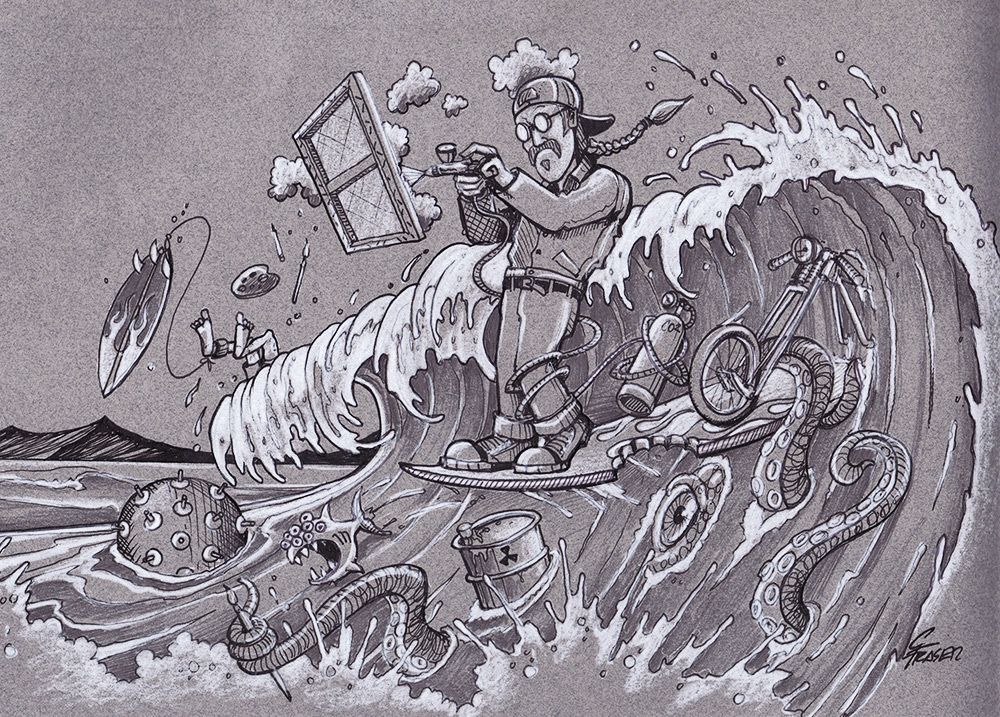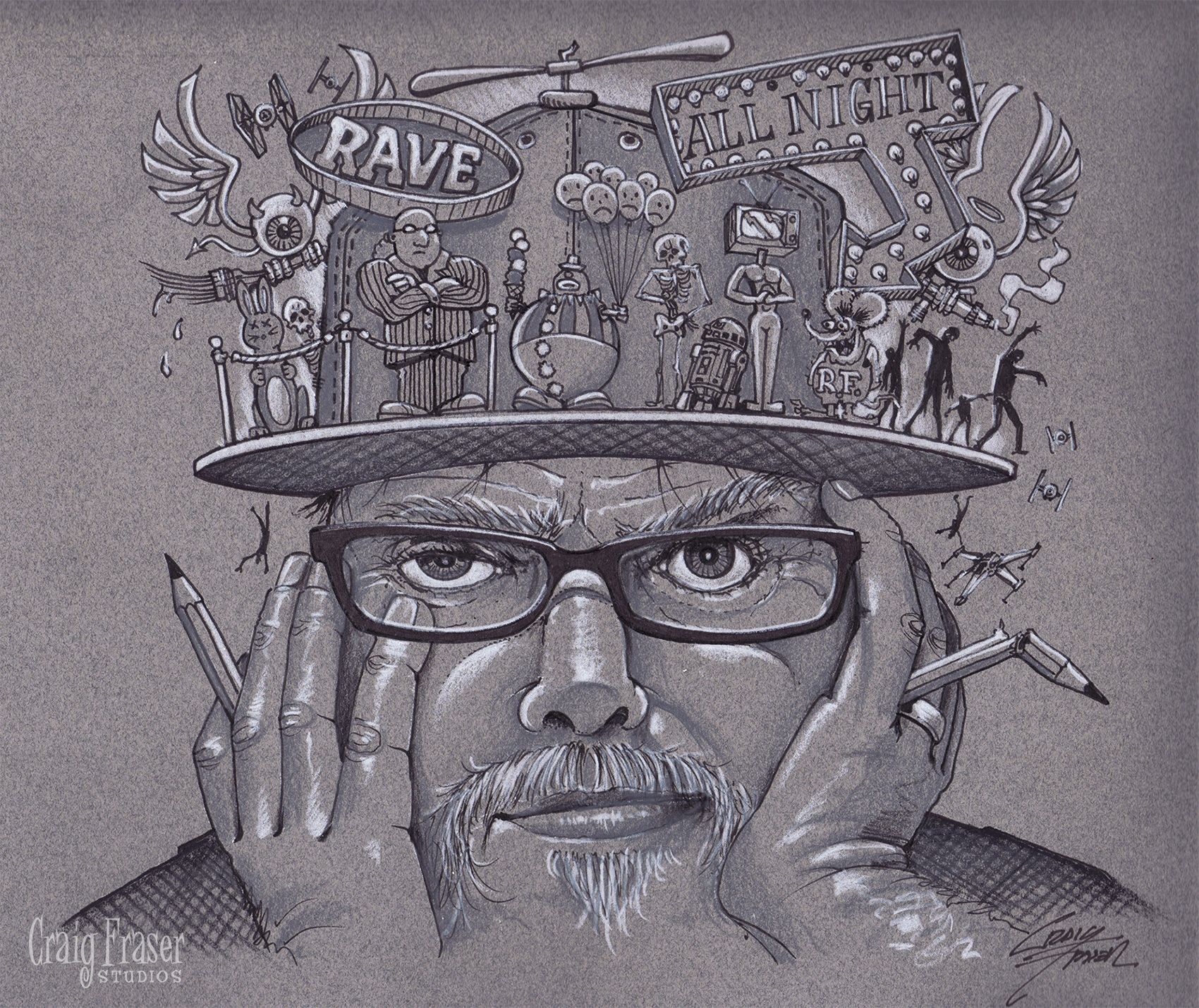One of my favorite comparisons when discussing the Kustom Kulture industry would have to be the Surf Analogy. Now you don’t have to be a surfer to understand it, and if you are, you may never have thought of the comparison to other aspects of your life or creative career.
First off, the primary concept of surfing is to simply interpret and ride the wave. Each successful surfer will do this in their own way, with the end result depending on their individual style and ability. The key point here is understanding that in the scheme of things, the surfer has little if any influence on the wave. The surfer is merely riding the wave. The elements that create the wave have no concern for the surfer. The waves continue whether the surfer is there or not.
A surfer can choose to ride a wave all the way into shore, and even up onto the beach, but this does not necessarily constitute a good ride. Surfing is more about quality not quantity. As a surfer it is crucial you learn to kick out of the wave at the right time. “Kicking out” is a form of early exit from the wave, which allows you to more easily paddle back and take advantage of more waves in that set. If you ride into shore on every wave, you will spend more time paddling out than actually surfing and will probably miss all the best waves. You’ll also be exhausted from battling the sets as you paddle out.
A good surfer will also be patient and wait for the best sets. Being able to read the waves, as well as the other surfers performance is a major educational tool. Surfing teaches you that no matter what, there will always be another wave, another set, another day. As surfers we do not make the waves, we ride them. The way we choose to ride them is based on our interpretation, style, and individual ability. That is our art. No two waves are alike and everyday presents a new challenge. The schooling is never finished. All good surfers acknowledge that.
The way I like to apply the “Surf analogy” to my creative process is as follows:
- Know your environment: Learn your subject by observation, experimentation and historical study. An informed artist is not just confident in his abilities, but also his surroundings. Like a surfer you cannot commit to your art unless you have all the tools at your disposal and know how to use them.
- Select your projects with the same interpretative approach as a surfer: If you only take on the simple junk, your art will reflect this lack of challenge. You will spend twice the energy, with half the quality of output. You may have a large volume of work, but with little impact.
- Learn when to kick out: All styles, jobs, trends and fads have a life-span. Within that lifespan is the sweet spot. Strive to be the innovator in this sweet spot, not the artist clinging to a played-out fad like a surfer riding in on the junk foam. There are always more waves. There are always more projects. Be choosy – the waves may be timeless, our lifespan is not.
- Always search for the next challenge: Just as there are different waves, different beaches, and different styles of surfing, there are different creative challenges for you as an artist. By going on to new challenges you are not abandoning your previous works, but will be honing your innovative skills and making them even better.
- There will be good days, and bad: As an artist you must take the good with the bad, not as consequence, but as a necessity in growth. Learn to take pride in your accomplishments, but take just as much pride in how you worked through the trial periods. “A bad day of surfing is better than the best day in the office”. As artists we are not solely judged by our successes, but also in how we have dealt with and learned from our failures.
- Never believe it is solely you: No matter how “Zen” a surfer may be, he will never believe he influences the waves. As artists we may think this part of the analogy does not apply to us since we can influence other artists and therefore our industry. This is an illusion. Without a continued challenge, new innovations in style, and a constant re-inventing of ourselves as artists we not only hold ourselves back, but also our industry. The world however, like the waves, goes on.
I have always enjoyed using analogies when teaching, or explaining a point of view. It allows me to consider the subject from a different perspective and often times allows the reader to remember it better by being in a different context. Analogies also show that basic truths are self evident no matter what scenario you present them in.
I hope my Surf Analogy has offered you a bit of insight as to how I approach, interpret and deal with the Kustom/Fine Art industry. If you have similar analogies, or comments concerning this subject I would love to read them. Please post and reshare.
Keep on Surfing!
Craig Fraser







Dude! I love your analogy…super stoke……and always love your real surf story in Morro Bay, CA.!
Thanks Michael! You know I may have to make the Morro Bay “Tales of the Surfgod” into a blogpost here. (Just not sure if there was a life lesson there… 😉
When I saw this piece the first thought was “Craig is going to paint come hell or high water.”
Then I read the piece. Kicking out is a challenge. I mean when will there ever be enough skulls, biomech, and tru fire. lol
When you kick out of a wave you don’t quite surfing forever! 😉 the same can be said for Biomech, skulls, flames etc. it is always good to come back and deal with a familiar style from a different perspective! Thanks for the comments!
Craig, right on the mark with this analogy, I couldn’t agree more. I love to use analogies too in sharing truth or life lessons. I’d add to this, being that I took one surf lesson in the Hawaii waves, one lesson and didn’t finish. To sum it up, I didn’t have the physical ability and the passion to get back up, take the salt water again up the nose, and get more board rash wasn’t flying with me. No surfer in my mind would take it on as an adult who didn’t grow up on a board, without the physical ability, passion, and determination. We have to have these key elements to our craft. Your journey sounds like you had a lot of talents and things you liked. Finding that thing that you’ll take the beatings, you want to get back on the board again, and you long to head out to the sets of waves again, seems also a key ingredient. This is a great lesson to remember about your creative field, waiting for good timing and not taking any chance to do any piece of cheap work. I love the lessons in this.
Do you mind if I quote a couple of your posts as long as I provide credit and sources back to your webpage?
My blog ste is in the very same area of interest as yours
and my users would definitely benefit from some of thhe information you present here.
Pleasse let me know if this okay with you. Thanks a lot!
Please feel free to quote, or share my blogs. Thankyou in advance for the credit. 😉
Howdy! This is my first cojment here so I just wanted
to give a quick shout out and tell you I really enjoy reading through your blog posts.
Can you recommend any other blogs/websites/forums that go over the same subjects?
Thank you so much!
Highly energetic article, I liked that a lot. Will there be a part 2?
Howdy! Do you use Twitter? I’d like to follow you if that would be ok.
I’m definitely enjoying your blog and look forward
to new posts.
Can you mind should i quote a few of your posts as long as
I provide credit and sources to your webpage? My blog is in the very
same region of interest as yours and my visitors
would really take advantage of many of the information you provide
here. Please tell me if this type of alright along with you.
Cheers!
Sure, thanks for the compliment, glad you could use the info!
Awesome. This analogy is spot on, not aimed at just the artist, but any creative in general. Thanks for taking the time to piece this to gather and sharing it.
Thanks Ryan! Glad you could use it! 😉